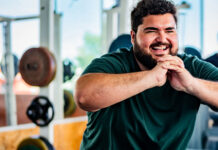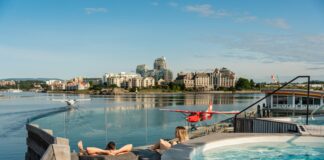Have you spent countless hours stretching, only to feel tight and stiff again the next day? You’re not alone. For years, exercisers believed that stretching is the key to being flexible and mobile.
What if I told you that stretching is not the best way to create sustained mobility and flexibility? I’m not saying that it’s bad. But there’s a better way to build mobility that lasts—and it doesn’t involve trying to “loosen” tight muscles.
MUSCLE CONTRACTION
Contrary to popular belief, muscles don’t actually stretch. The vast majority of muscle is made up of proteins and tissue that allow for rapid contraction and relaxation of muscle tissue. So this begs the question, “If such a miniscule portion of muscle has any kind of elasticity, why can I stretch them?”
Think of your muscles like Velcro shoes. Just like fastening and unfastening the Velcro to have the shoes fit snugger, your muscular cells unstitch and restitch at incredible speeds to create movement of your joints.
Here’s where we got it wrong for years: the sensation you get when you are moving through a deep “stretch” is your muscle contracting near its limit, telling you that you are getting close to your tolerable end-range of motion. It’s your body putting on “the brakes” on movement so you don’t exceed the excursion your joints can move through and damage your tissues.
As the “stretch” gets deeper, your muscles contract harder, so the “stretch” sensation becomes more present, telling you to be careful.
IMPROVING MOBILITY AND FLEXIBILITY
So, if muscles don’t stretch, what creates mobility? It’s the beautiful union between the muscles’ ability to contract (your strength) and your brain’s neuroplasticity (ability to learn). Your brain is the great regulator of movement. It receives information about joint health and muscular strength thousands of times per second. It takes that constant flow of information and creates a blueprint for how to move your muscles based on what you are asking your body to do.
Using that blueprint, it sends signals back out through your body to create smooth, precise movement. Like a feedback loop, your brain will continue to update your movement blueprint with the new information coming to it on a millisecond-by-millisecond basis.
This next part is crucial; if you have the strength to move into a position, your brain will allow you to move there. If you try to move into a position and you don’t have the strength to do so, your body will shut down your range of motion. You’ll feel your muscles tighten up to restrict you from moving yourself into a compromising position. It’s not tight muscles stopping your range of motion from opening up…it’s the weak ones!
If you want to have more mobility and flexibility, the best thing you can do is get your joints and muscles stronger in end-range positions.
It’s one of the reasons yoga works to create mobility for so many people; yogis visit all sorts of end-range positions with their joints and challenge them there. This increases their strength and endurance in those positions, so they can have more freedom of movement even when they aren’t practicing yoga.
This is also why resistance training is effective at improving mobility; you can perform exercises to challenge your muscles in end-range positions to meet your mobility needs. Resistance training has the added benefit of being progressive—you can add reps, time, sets, load—which means you can continue to challenge your new-found mobility and have it carry over to real world circumstances.
REVERSE STRETCHING
I advocate reverse stretching to improve mobility, rather than trying to “stretch” the body to open up. This method of “reverse stretching” (credit to my colleague Brandon Green for coining the term) takes advantage of a neuromuscular phenomenon called post-activation potentiation (PAP).
PAP is like giving your muscles a “wake-up call.” After doing a short- to moderate-length muscular contraction, your muscles become more alert and ready to perform better. This makes your next movements stronger, faster, happening through a greater range of motion.
Imagine putting on a new pair of snug jeans that feel a bit restrictive at first. Instead of forcing quick movements that could tear or ruin the fabric, you start with slow, deliberate actions—carefully bending and holding at the limits of your mobility. The fabric becomes more forgiving and allows you to move more freely.
Similarly, PAP uses controlled muscular contractions at the far ends of your joint positions, gradually preparing your muscles to move fluidly and easily, much like how the jeans become more comfortable and flexible with each measured increase in motion.
Reverse stretching flips the technique of traditional stretching. Instead of focusing on holding a stretch to relax tight muscles, you actively engage and contract muscles on the opposite side of the body that would pull you into a deeper range of motion. This approach utilizes PAP to improve both your strength and mobility by priming your muscles to work at their limits of range of motion.
Let’s look at a quick example:
Traditional Stretch: In a typical hamstring stretch, you might sit on the floor with your legs straight in front of you. You’d reach toward your toes, gripping them with your hands, and forcing yourself deeper by pulling forward to passively lengthen your hamstrings.
Reverse Stretch: You’d sit in the same position, but instead of just reaching forward and holding, you’d contract your muscles. As you lean toward your toes, moderately contract your quads and core while squeezing yourself gently forward using your muscles. Hold this contraction for a few seconds, then release slightly, and repeat three to five times. This controlled contraction at the end-range helps activate the muscles, increasing their strength and allowing them to “learn” how to move through a wider range of motion.
You can literally take any passive stretch and turn it into an active reverse stretch.
Utilizing PAP, reverse stretching, and resistance training will teach your neuromuscular system to learn and maintain greater ranges of motion far more effectively than passive stretching. It’s simple, safe, effective, and backed rigorously by science. Give it a try for a week, I guarantee you will notice the effects instantaneously.
MUSCLE CONTRACTION
Contrary to popular belief, muscles don’t actually stretch. The vast majority of muscle is made up of proteins and tissue that allow for rapid contraction and relaxation of muscle tissue. So this begs the question, “If such a miniscule portion of muscle has any kind of elasticity, why can I stretch them?”
Think of your muscles like Velcro shoes. Just like fastening and unfastening the Velcro to have the shoes fit snugger, your muscular cells unstitch and restitch at incredible speeds to create movement of your joints.
Here’s where we got it wrong for years: the sensation you get when you are moving through a deep “stretch” is your muscle contracting near its limit, telling you that you are getting close to your tolerable end-range of motion. It’s your body putting on “the brakes” on movement so you don’t exceed the excursion your joints can move through and damage your tissues.
As the “stretch” gets deeper, your muscles contract harder, so the “stretch” sensation becomes more present, telling you to be careful.
IMPROVING MOBILITY AND FLEXIBILITY
So, if muscles don’t stretch, what creates mobility? It’s the beautiful union between the muscles’ ability to contract (your strength) and your brain’s neuroplasticity (ability to learn). Your brain is the great regulator of movement. It receives information about joint health and muscular strength thousands of times per second. It takes that constant flow of information and creates a blueprint for how to move your muscles based on what you are asking your body to do.
Using that blueprint, it sends signals back out through your body to create smooth, precise movement. Like a feedback loop, your brain will continue to update your movement blueprint with the new information coming to it on a millisecond-by-millisecond basis.
This next part is crucial; if you have the strength to move into a position, your brain will allow you to move there. If you try to move into a position and you don’t have the strength to do so, your body will shut down your range of motion. You’ll feel your muscles tighten up to restrict you from moving yourself into a compromising position. It’s not tight muscles stopping your range of motion from opening up…it’s the weak ones!
If you want to have more mobility and flexibility, the best thing you can do is get your joints and muscles stronger in end-range positions.
It’s one of the reasons yoga works to create mobility for so many people; yogis visit all sorts of end-range positions with their joints and challenge them there. This increases their strength and endurance in those positions, so they can have more freedom of movement even when they aren’t practicing yoga.
This is also why resistance training is effective at improving mobility; you can perform exercises to challenge your muscles in end-range positions to meet your mobility needs. Resistance training has the added benefit of being progressive—you can add reps, time, sets, load—which means you can continue to challenge your new-found mobility and have it carry over to real world circumstances.
REVERSE STRETCHING
I advocate reverse stretching to improve mobility, rather than trying to “stretch” the body to open up. This method of “reverse stretching” (credit to my colleague Brandon Green for coining the term) takes advantage of a neuromuscular phenomenon called post-activation potentiation (PAP).
PAP is like giving your muscles a “wake-up call.” After doing a short- to moderate-length muscular contraction, your muscles become more alert and ready to perform better. This makes your next movements stronger, faster, happening through a greater range of motion.
Imagine putting on a new pair of snug jeans that feel a bit restrictive at first. Instead of forcing quick movements that could tear or ruin the fabric, you start with slow, deliberate actions—carefully bending and holding at the limits of your mobility. The fabric becomes more forgiving and allows you to move more freely.
Similarly, PAP uses controlled muscular contractions at the far ends of your joint positions, gradually preparing your muscles to move fluidly and easily, much like how the jeans become more comfortable and flexible with each measured increase in motion.
Reverse stretching flips the technique of traditional stretching. Instead of focusing on holding a stretch to relax tight muscles, you actively engage and contract muscles on the opposite side of the body that would pull you into a deeper range of motion. This approach utilizes PAP to improve both your strength and mobility by priming your muscles to work at their limits of range of motion.
Let’s look at a quick example:
Traditional Stretch: In a typical hamstring stretch, you might sit on the floor with your legs straight in front of you. You’d reach toward your toes, gripping them with your hands, and forcing yourself deeper by pulling forward to passively lengthen your hamstrings.
Reverse Stretch: You’d sit in the same position, but instead of just reaching forward and holding, you’d contract your muscles. As you lean toward your toes, moderately contract your quads and core while squeezing yourself gently forward using your muscles. Hold this contraction for a few seconds, then release slightly, and repeat three to five times. This controlled contraction at the end-range helps activate the muscles, increasing their strength and allowing them to “learn” how to move through a wider range of motion.
You can literally take any passive stretch and turn it into an active reverse stretch.
Utilizing PAP, reverse stretching, and resistance training will teach your neuromuscular system to learn and maintain greater ranges of motion far more effectively than passive stretching. It’s simple, safe, effective, and backed rigorously by science. Give it a try for a week, I guarantee you will notice the effects instantaneously.
You may also like: Switching from Stretching to Mobilization

Read This Story in Our 2024 Fall Fitness Issue
IMPACT Magazine Fall Fitness Issue 2024 featuring Canadian figure skating icon Elladj Baldé, Paralympic shot putter Greg Stewart, Indigenous rights trail running Anita Cardinal. Adventure travel with some amazing winter getaways, strengthen your back and hips, find the art of joyful movement, Inclusivity in the fitness industry and so much more!

















